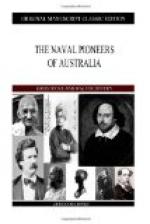But the most important change that had come to the sea service was in the methods of finding a ship’s position at sea. Hadley’s sextant was in use in 1731, Harrison’s chronometer in 1762, and five years later the first number of the Nautical Almanac was published, so that when Cook sailed longitude was no longer found by rule of thumb, and the great navigator, more than any other man, was able to and did, prove the value of these discoveries.
In 1764 Byron, who had been a midshipman on the Wager, sailed as commodore of an expedition consisting of two ships, the Dolphin and the Tamar, to make discoveries in the Southern Hemisphere. This voyage of discovery was the first English scientific expedition since that of the Roebuck. Byron returned in 1766 without touching at New Holland, his principal discovery being the Falkland Islands. Three months after his return another expedition sailed under the command of Wallis in the Dolphin, and with Carteret in the Swallow. The voyage resulted in many minor discoveries, but will be chiefly remembered for that of Tahiti and the story of Wallis’ stay there. The Dolphin [Sidenote: 1766-1769] reached England in May, 1768. The two vessels had previously separated in Magellan Straits; and the Swallow, pursuing a different course to that taken by the Dolphin, made many discoveries, including Pitcairn Island; the Sandwich Group; and several islands in the neighbourhood of New Guinea, New Ireland and the Admiralty Islands. The Swallow reached England six months after Cook sailed. The Dolphin’s return so long before her consort alarmed the Admiralty for the safety of the Swallow, and Carteret on his way home, falling in with the French scientific expedition under Bougainville, who himself had been exploring in the Pacific, was informed that two vessels had been sent out to search for him and his men, who, it was thought, might be cast away in the Straits of Magellan.
Dampier’s voyage was made solely for discovery purposes; Anson, who forty years later went into the South Seas and so near to Australia as the Philippines, had gone out to fight; Byron, Wallis, and Carteret, who immediately preceded Cook, had sailed to discover and chart new countries; but Cook, who made the greatest discovery and did more important charting than all of them put together, sailed in the Endeavour for the purpose of making certain astronomical observations, and exploration was only a secondary object of the voyage. Wallis’ return determined the spot where the observations could best be carried out; and, on his advice, Cook was ordered to make for Port Royal, in Tahiti.




